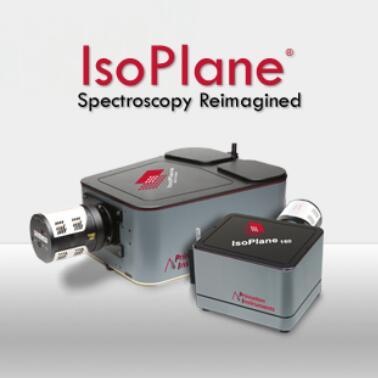|
参考报价:电议 型号:
产地:美国 在线咨询
|

美国PI 公司作为科学级CCD 相机和光谱仪的**者,经过数十载技术创新,推出首台全焦面零像差成像光谱仪Fergie。它采用内置高灵敏度科学级CCD 芯片的全集成式紧凑设计,*简化光谱实验硬件设置。零像差不仅**化提高了光谱分辨率,也让成像和光谱的切换轻松自如。辅以Fergie CUBEs 模块化设计,无论是吸收、透射光谱,或是荧光、拉曼光谱,光路搭建都变得易如反掌。
IsoPlane成像型光谱仪
行业高级的成像光谱仪
IsoPlane 成像光谱仪重新定义了高性能与多功能的标准。
这款**设计,屡获嘉奖的IsoPlane是成像光谱仪中非常好的产品。 f/4.6的光路在提供非常好的成像质量的同时,还保证了非常大的光通量和信噪比。独特的光学设计完全消除了焦平面上的像差,具有无以伦比的多通道成像能力,是一款独特的产品。
IsoPlane-160是一款小巧的200mm焦距成像光谱仪,拥有f/3.88光路,独特的像差纠正设计,成像质量高,成像分辨率可以媲美1/3米焦距的传统C-T型光谱仪(Czerny-Turner)。 IsoPlane-160小巧而性能强大。
IsoPlane系列具有以下优点:
* 高分辨率成谱
* 非常好的成像能力
* 出色的信噪比
* **光学设计(IsoPlane-320)
* 三重光栅塔轮,自动化操作,具有光栅识别能力
产品综述
****的全面性! 普林斯顿仪器不断创新的传统在这款屡获嘉奖的IsoPlane-320上再次得到展现,它独特的零像差光学设计让图像和光谱的分辨率大幅度提高,同时还拥有更强的光通量。其分辨率可以媲美1/2米焦长的光谱仪,却是其光通量的两倍,使得IsoPlane成为高要求低光实验中理想的选择。 IsoPlane-160用非常小巧的设计达到了1/3米焦长光谱仪才能达到的分辨率。 它 f/3.88的光学设计几乎完全消除了像差,也保证了高分辨率。 不仅是光谱应用,也是显微光谱仪的理想选择。 IsoPlane的常用领域包括: * 显微光谱仪:拉曼,荧光和光致发光 * 多通道光谱仪 * 拉曼光谱 * 荧光和光致发光光谱 * 激光诱导击穿谱仪(LIBS) * 生物医学成像 * 傅里叶频谱 |
产品特点
IsoPlane-320 **设计,零像散设计 全波长,全部焦平面零像散,高分辨率 避免信号串扰,同时采集>100光纤输入信号 可充分利用大尺寸CCD的成像空间,芯片高度可达达22mm 其他任何反射型光谱仪难以匹配的性能 |
高光通量 每个像素可收集更多的光子,提升光谱分辨率和对比度 更高的信号强度提高实验的灵敏度 (C6H6 1460 cm-1 image). |
三光栅塔轮,全软件控制 探测范围从UV到mid-IR,软件选择中心波长,全面的实验灵活性优于棱镜型光谱仪 优化的色散效率和分辨率,只需一键实现 光栅塔轮可快速更换,系统可支持高达9块光栅 |
精准的千分尺调整 可调整光谱与相机的聚焦效果 提升光谱和相机的分辨率 |
高效率光学镀膜 Acton#1900 增强型铝膜反射镜提供从193nm到mid-IR的非常高反射率. 保护性银膜提供平均>98%的反射率. 近红外可以选择金膜. |
兼容普林斯顿仪器各类相机 PIXIS CCD cameras ProEM EMCCD cameras PI-MAX4 ICCDs and emICCD cameras NIRvana InGaAs NIR/SWIR cameras |
全面的附件 光纤束,滤波转轮,光源,光栅等等. IntelliCal 波长校准和强度校准系统 点击查看其他各种附件 |
LightField的64-位操作平台 与LabVIEW,MATLAB,EPICS等第三方软件无缝对接. 直观易上手的用户界面设计. 内置数学引擎,实时获得图像与光谱的数据分析. |
型号规格
IsoPlane成像光谱仪产品参数与手册
Model | Focal Length | Aperture Ratio | PMT Resolution* | CCD Resolution |
IsoPlane SCT-320 | 320 mm | f/4.6 | 0.05 nm | 0.08 nm |
IsoPlane 160 | 203 mm | f/3.88 | 0.10 nm | 0.15 nm |
Specifications determined with 1200 gr/mm grating at 435 nm with 26.8 mm width CCD camera with 20 μm pixels
*10 μm slit widths, 4 mm height
产品应用
Tip-Enhanced Raman Spectroscopy TERS - Tip-Enhanced Raman spectroscopy Laser-Induced Breakdown Spectroscopy LIBS is considered one of the most convenient and efficient analytical techniques for trace elemental analysis in gases, solids, and liquids. LIBS spectra obtained by the Mars Curiosity Rover have confirmed that our sister planet could have harbored life Fluorescence, Phosphorescence, and Photoluminescence Spectroscopy Fluorescence, phosphorescence and photoluminescence occur when a sample is excited by absorbing photons and then emits them with a decay time that is characteristic of the sample environment. General Raman The most common application of Raman spectroscopy involves the vibrational energy levels of a molecule. Incident laser light in the UV, visible or NIR, is scattered from molecular vibrational modes. Surface-Enhanced Raman Spectroscopy SERS - Surface-enhanced Raman spectroscopy Coherent Anti-Stokes Raman Spectroscopy Coherent Anti-Stokes Raman spectroscopy (CARS) a type of non-linear Raman spectroscopy. Instead of the traditional single laser, two very strong collinear lasers irradiate a sample. Singlet Oxygen Imaging Singlet oxygen, the first excited state of molecular oxygen, is a highly reactive species that plays an important role in a wide range of biological processes, including cell signaling, immune response, macromolecule degradation, and elimination of neoplastic tissue during photodynamic therapy. Combustion Combustion researchers rely on laser-based optical diagnostic techniques as essential tools in understanding and improving the combustion process. Plasma Emission Spectroscopy The different types of plasma emission spectroscopy can be categorized by how the plasma is generated. Spectra of nuclear fusion plasmas are used to ascertain the chemical species present and other properties. Resonance Raman Spectroscopy Instead of fluorescence, some types of colored molecules produce strong Raman scattering at certain conditions. This effect was called Resonance Raman. Stimulated Raman Scattering Stimulated Raman scattering takes place when an excess of Stokes photons that were previously generated by normal Raman scattering are present or are deliberately added to the excitation beam. |